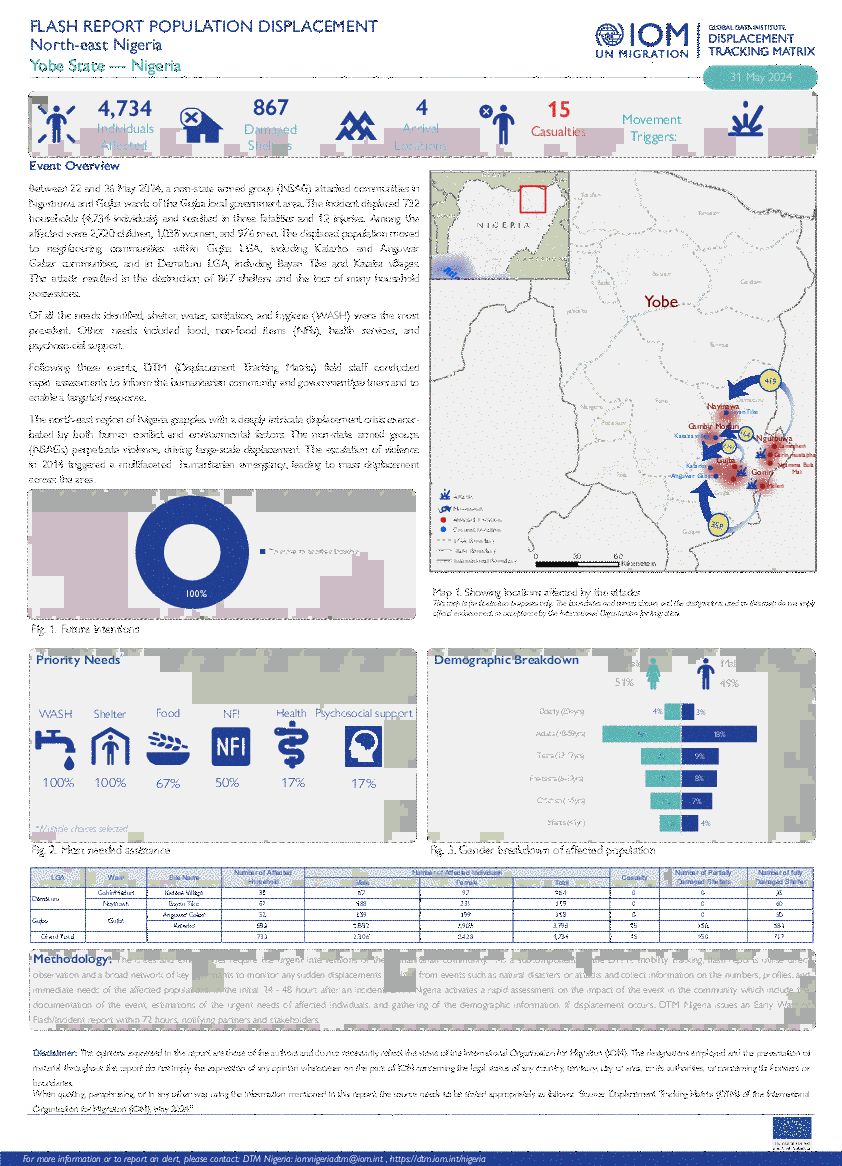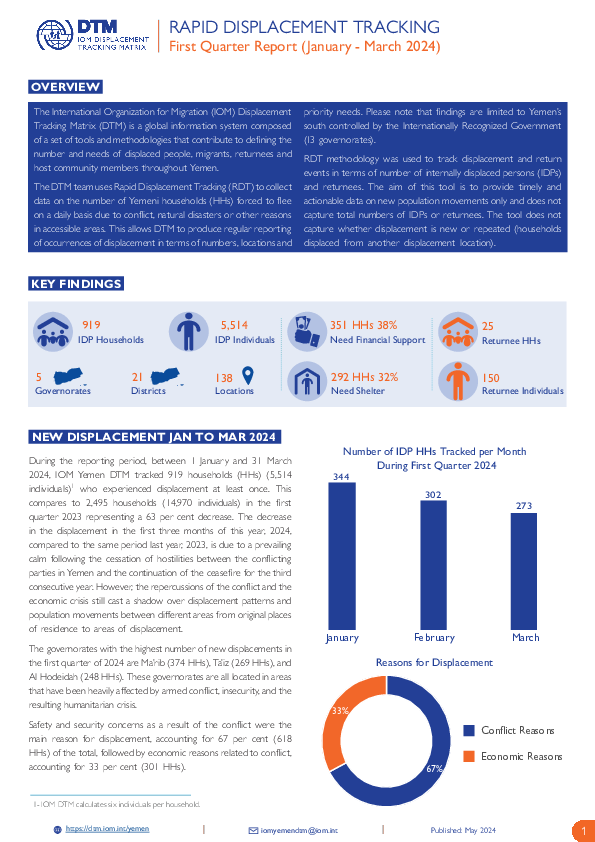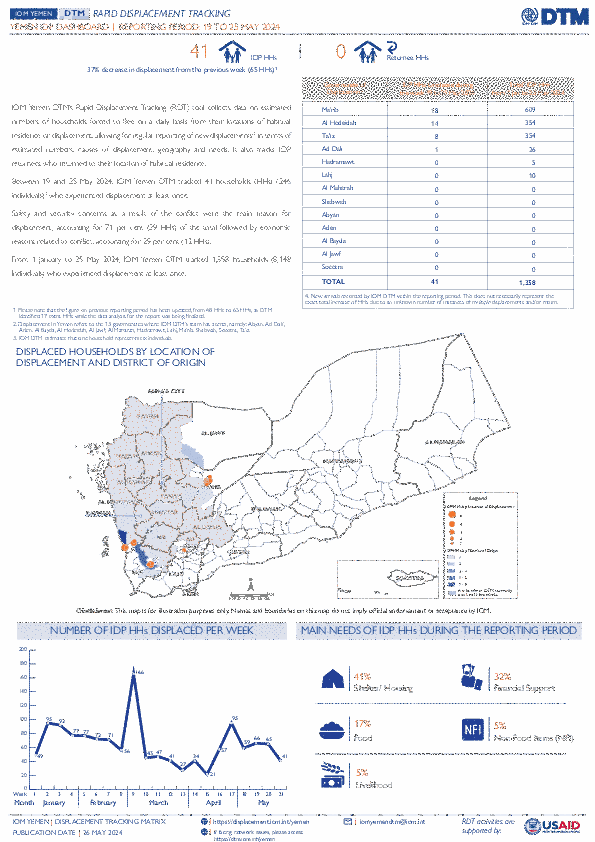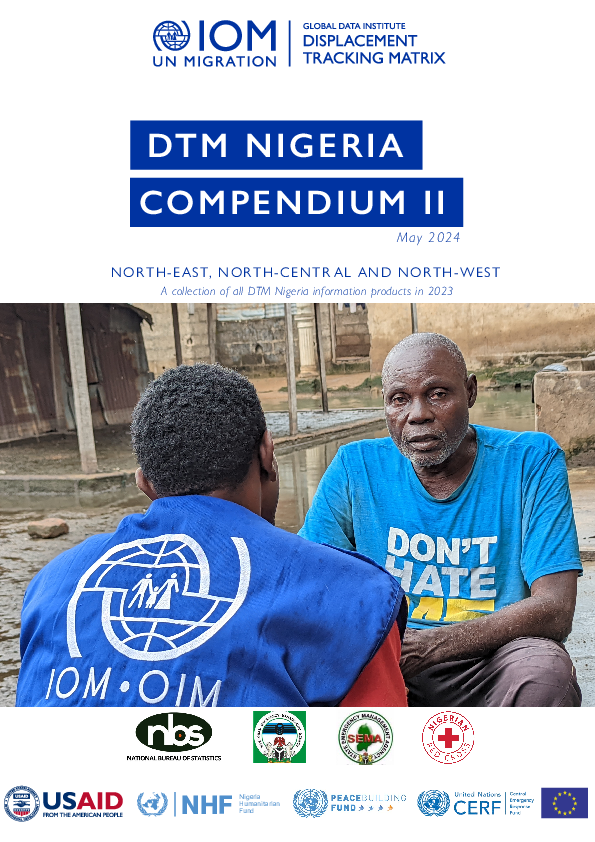-
Countries
-
Data and Analysis
-
Special Focus
-
Crisis Responses
Event Tracking

Contact
iomnigeriadtm@iom.int
Language
English
Location
Nigeria
Period Covered
May 22 2024
May 26 2024
Activity
- Mobility Tracking
- Event Tracking
Between 22 and 26 May 2024, a non-state armed group (NSAG) attacked communities in Ngurbuwa and Gujba wards of the Gujba local government area. The incident displaced 732 households (4,734 individuals) and resulted in three fatalities and 12 injuries. Among the affected were 2,720 children, 1,038 women, and 976 men. The displaced population moved to neighbouring communities within Gujba LGA, including Katarko and Anguwar Gabar communities, and in Damaturu LGA, including Bayan Tike and Kasaisa villages. The attack resulted in the destruction of 867 shelters and the loss of many household possessions.
Of all the needs identified, shelter, water, sanitation, and hygiene (WASH) were the most prevalent. Other needs included food, non-food items (NFIs), health services, and psychosocial support.
Following these events, DTM (Displacement Tracking Matrix) field staff conducted rapid assessments to inform the humanitarian community and government/partners and to enable a targeted response.
The north-east region of Nigeria grapples with a deeply intricate displacement crisis exacerbated by both human conflict and environmental factors. The non-state armed groups (NSAGs) perpetuate violence, driving large-scale displacement. The escalation of violence in 2014 triggered a multifaceted humanitarian emergency, leading to mass displacement across the area.
Contact
DTM Yemen, iomyemendtm@iom.int
Location
Yemen
Activity
- Mobility Tracking
- Event Tracking
Period Covered
Jan 01 2024 -Mar 31 2024
From 1 January to 31 March 2024, IOM Yemen DTM tracked 919 households (HH) (5,514 Individuals) who experienced displacement at least once.
Between 1 January and 31 March 2024, IOM Yemen DTM tracked 919 households (5514 individuals) displaced at least once. The majority of people moved into/within the following governorates and districts:
- Ma’rib (374 HHs) – Marib City (199 HHs), Marib (129 HHs), Harib (46 HHs) districts. Most displacements in the governorate originated from Marib and Al Hodeidah.
- Ta’iz (269 HHs) – Jabal Habashi (168 HHs), Al Makha (33 HHs), Al Maafer (24 HHs) districts. Most displacements in the governorate were internal.
- Al Hodeidah (248 HHs) – Al Khukhah (135 HHs), Hays (113 HHs) districts. Most displacements in the governorate originated from Al Hodeidah and Taiz.
The majority of people moved from the following governorates and districts:
- Ta’iz (360 HHs) – Jabal Habashi (16 HHs), Mawza (3 HHs), Hayfan (1 HH) districts.
- Al Hodeidah (248 HHs) – Bajil (6 HHs), As Sukhnah (5 HHs), Jabal Ras (1 HH) districts.
- Ma’rib (97 HHs) – Majzar (2 HHs), Al Jubah (1 HH) districts.
Population Groups
IDPs
Returnee (Previously Internally Displaced)
Survey Methodology
Unit of Analysis Or Observation
Admin Area 2
Household
Site or Location
Type of Survey or Assessment
Household
Key Informant
Keywords
Geographical Scope Partial Coverage
Administrative boundaries with available data
The current dataset covers the following administrative boundaries

Contact
DTM Yemen, iomyemendtm@iom.int
Language
English
Location
Yemen
Period Covered
Jan 01 2024
Mar 31 2024
Activity
- Mobility Tracking
- Event Tracking
During the reporting period, between 1 January and 31 March 2024, IOM Yemen DTM tracked 919 households (HHs) (5,514 individuals)1 who experienced displacement at least once. This compares to 2,495 households (14,970 individuals) in the first quarter 2023 representing a 63 per cent decrease. The decrease in the displacement in the first three months of this year, 2024, compared to the same period last year, 2023, is due to a prevailing calm following the cessation of hostilities between the conflicting parties in Yemen and the continuation of the ceasefire for the third consecutive year. However, the repercussions of the conflict and the economic crisis still cast a shadow over displacement patterns and population movements between different areas from original places of residence to areas of displacement.
The governorates with the highest number of new displacements in the first quarter of 2024 are Ma’rib (374 HHs), Ta’iz (269 HHs), and Al Hodeidah (248 HHs). These governorates are all located in areas that have been heavily affected by armed conflict, insecurity, and the resulting humanitarian crisis.
Safety and security concerns as a result of the conflict were the main reason for displacement, accounting for 67 per cent (618 HHs) of the total, followed by economic reasons related to conflict, accounting for 33 per cent (301 HHs).

Contact
DTM Support — iomdrcdtm@iom.int
Language
French
Location
Democratic Republic of the Congo
Period Covered
May 09 2024
May 19 2024
Activity
- Mobility Tracking
- Event Tracking
Le territoire de Kalehe, dans la partie nord de la province du Sud-Kivu, est confronté à une crise humanitaire aggravée par un conflit armé persistant. La crise actuelle du M23 dans la province du Nord-Kivu a encore compliqué la situation déjà instable, entraînant un déplacement massif de personnes du Nord-Kivu vers Kalehe et la fermeture de la route reliant Minova (Kalehe) au Nord-Kivu et à la capitale provinciale de Goma. La situation à Kalehe se caractérise par une détérioration de l'accès aux moyens de subsistance, tant pour les populations déplacées que pour les populations d'accueil, une aggravation des conditions de vie et des préoccupations croissantes en matière de protection. L'intensification des combats depuis le début du mois de mai 2024 dans le territoire de Masisi au Nord-Kivu (groupements de Mupfunyi Matanda, Mupfunyi-Kibabi, Mupfunyi-Shanga et Ufamandu) a entraîné des déplacements préventifs des populations locales vers le Sud-Kivu, en particulier vers les groupements de Mbinga-Nord, Buzi, Kalima et Ziralo. Les personnes déplacées se sont installées dans la communauté d'accueil ainsi que dans des centres collectifs à travers une région qui a déjà reçu plusieurs vagues de personnes déplacées au cours des derniers mois. Les systèmes d'aide humanitaire et communautaire sont de plus en plus sous pression dans les zones de refuge où l'assistance est très limitée et où les ressources disponibles localement dans le territoire de Kalehe sont insuffisantes. La situation sécuritaire dans la région reste imprévisible, limitant l'accès humanitaire dans la majeure partie du territoire de Kalehe, dans les groupements de Buzi, Ziralo et Alima.

Contact
DTM Support — iomdrcdtm@iom.int
Language
French
Location
Democratic Republic of the Congo
Period Covered
May 08 2024
May 12 2024
Activity
- Mobility Tracking
- Event Tracking
Depuis le début de l'année 2024, le niveau des rivières Moba et Mulobozi, y compris celui du lac Tanganyika, a fortement augmenté dans le territoire de Moba, province du Tanganyika, en raison de la persistance de fortes pluies. Cette situation continue de provoquer de fortes inondations, des glissements de terrain et de l'érosion, ainsi que des dommages importants aux maisons et aux biens dans la ville de Moba-Port et dans les villages situés tout au long de la rive du lac, sur l'axe Mpala-Moliro. Cette situation a provoqué des déplacements massifs de ménages vivant dans plusieurs localités dont celles de Tanganyika, Moba, Kituku, Port, Kinzungi, Kisi, Nkuba, Kitumba, Kansenge, et Kileba, avec une évaluation provisoire des dégâts de 3 360 maisons détruites. Il est fréquemment fait état de dégâts importants aux infrastructures publiques et privées, notamment à deux ports, huit écoles, des églises et des marchés, entre autres. La DTM estime que 4 119 ménages ont trouvé refuge dans des familles d'accueil à la fois dans les zones touchées par les inondations et dans celles qui ne le sont pas. Dans la plupart des cas, les conditions de vie sont très difficiles. Le risque de propagation de maladies transmises par l'eau, comme le choléra, constitue une menace sérieuse pour la santé publique dans la région. D'autres besoins prioritaires - notamment en matière d'abris, d'articles de première nécessité et de nourriture - nécessitant une action urgente et coordonnée se font sentir.

Contact
DTM Cameroon, DTMCameroun@iom.int
Language
French
Location
Cameroon
Period Covered
May 22 2024
May 26 2024
Activity
- Mobility Tracking
- Event Tracking
Le suivi des situations d’urgence (en anglais, Emergency Tracking Tool, ETT) est une des composantes de la Matrice de suivi des déplacements (en anglais, Displacement Tracking Matrix, DTM) déployée par l’Organisation Internationale pour les Migrations (OIM). Il a pour objectif de rassembler des informations sur les mouvements significatifs et soudains de populations, ainsi que sur des urgences sécuritaires et climatiques. Les données ont été collectées par observation directe et par des entretiens téléphoniques, auprès de dix informateurs clés, principalement des autorités locales, des organisations non-gouvernementales (ONG), des organisations de la société civile (OSC) et des représentants des populations dans les lieux affectés.
Ce tableau de bord présente des informations sur le déplacement de populations des localités de Tourou et Dinglding se sont déplacées vers les localités de Mokolo centre (Zimangayak, Ldamtsai Carrefour Dongoi, Ouro-Kessoum; Wayam-Tambak,Mendèzé) , Wandai et Ldamang dans l’arrondissement de Mokolo, département du Mayo-Tsanaga.
Contact
DTM Yemen, iomyemendtm@iom.int
Location
Yemen
Activity
- Mobility Tracking
- Event Tracking
Period Covered
May 19 2024 -May 25 2024
From 1 January to 25 May 2024, IOM Yemen DTM tracked 1,358 households (HH) (8,148 Individuals) who experienced displacement at least once.
Between 19 and 25 May 2024, IOM Yemen DTM tracked 41 households (246 individuals) displaced at least once. The majority of people moved into/within the following governorates and districts:
- Ma’rib (18 HHs) – Ma’rib City (14 HHs), Ma’rib (4 HHs) districts. Most displacements in the governorate originated from Al Hodeidah and Al Jawf.
- Al Hodeidah (14 HHs) – Al Khukhah (8 HHs), Hays (6 HHs) districts. Most displacements in the governorate originated from Al Hodeidah and Ta’iz.
- Ta’iz (8 HHs) – Jabal Habashi (8 HHs) district. All displacements in the governorate were internal.
The majority of people moved from the following governorates and districts:
- Al Hodeidah (15 HHs) – At Tuhayta (9 HHs), Hays (3 HHs), Al Marawiah (1 HH) districts.
- Ta’iz (14 HHs) – Al Maafer (6 HHs), Maqbanah (5 HHs), Ash Shamayatayn (1 HH) districts.
- Al Jawf (2 HHs) – Al Hazm (2 HHs) district.
Population Groups
IDPs
Returnee (Previously Internally Displaced)
Survey Methodology
Unit of Analysis Or Observation
Admin Area 2
Household
Site or Location
Type of Survey or Assessment
Household
Key Informant
Keywords
Geographical Scope Partial Coverage
Administrative boundaries with available data
The current dataset covers the following administrative boundaries

Contact
DTM Yemen, iomyemendtm@iom.int
Language
English
Location
Yemen
Period Covered
May 19 2024
May 25 2024
Activity
- Rapid Emergency Registration
- Mobility Tracking
- Event Tracking
IOM Yemen DTM’s Rapid Displacement Tracking (RDT) tool collects data on estimated numbers of households forced to flee on a daily basis from their locations of origin or displacement, allowing for regular reporting of new displacements in terms of estimated numbers, geography, and needs. It also tracks returnees who returned to their location of origin.
From 1 January to 25 May 2024, IOM Yemen DTM tracked 1,358 households (HH) (8,148 Individuals) who experienced displacement at least once.
Between 19 and 25 May 2024, IOM Yemen DTM tracked 41 households (246 individuals) displaced at least once. The majority of people moved into/within the following governorates and districts:
- Ma’rib (18 HHs) – Ma’rib City (14 HHs), Ma’rib (4 HHs) districts. Most displacements in the governorate originated from Al Hodeidah and Al Jawf.
- Al Hodeidah (14 HHs) – Al Khukhah (8 HHs), Hays (6 HHs) districts. Most displacements in the governorate originated from Al Hodeidah and Ta’iz.
- Ta’iz (8 HHs) – Jabal Habashi (8 HHs) district. All displacements in the governorate were internal.
The majority of people moved from the following governorates and districts:
- Al Hodeidah (15 HHs) – At Tuhayta (9 HHs), Hays (3 HHs), Al Marawiah (1 HH) districts.
- Ta’iz (14 HHs) – Al Maafer (6 HHs), Maqbanah (5 HHs), Ash Shamayatayn (1 HH) districts.
- Al Jawf (2 HHs) – Al Hazm (2 HHs) district.
IOM identified 17 additional households displaced in the previous reporting period, which covered 12 - 18 May 2024, in the governorates of Al Hodeidah (8 HHs), Ma’rib (5 HHs), and Ta’iz (4 HHs). These figures have been added to the cumulative displacement total recorded since the beginning of the year.

Contact
DTMMozambique@iom.int
Language
English
Location
Mozambique
Period Covered
May 10 2024
May 21 2024
Activity
- Mobility Tracking
- Event Tracking
Between 10 to 21 May 2024, attacks, and fear of attacks by Non-state Armed Groups in Macomia and Quissanga triggered the cumulative displacement of 4,521 individuals/ 1,351 families. The current Movement Alert #114 reports on most recent attacks in Northen Cabo Delgado. For more information on displacements between January and April, please see {Emergency Tracking Online Dashboard}.

Contact
DTM Nigeria, iomnigeriadtm@iom.int
Language
English
Location
Nigeria
Period Covered
Jan 01 2023
Dec 31 2023
Activity
- Other
- Survey
- Flow Monitoring Survey
- Return Intention
- Registration
- Biometric Registration
- Flow Monitoring
- Mobility Tracking
- Site Assessment
- Event Tracking
A collection of all DTM Nigeria information products in 2023.
Pagination
- Previous page
- Page 29
- Next page
